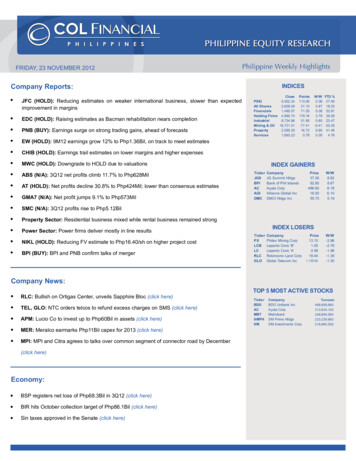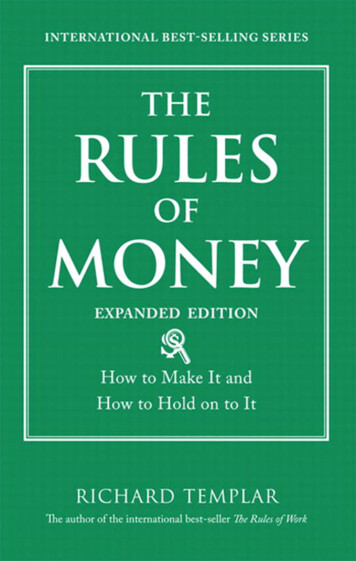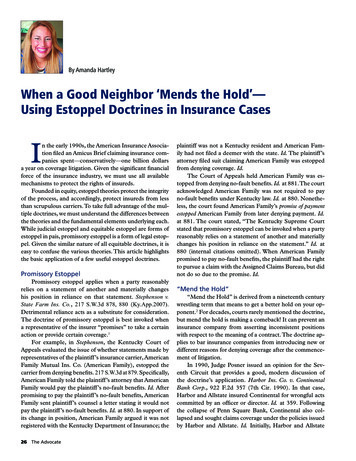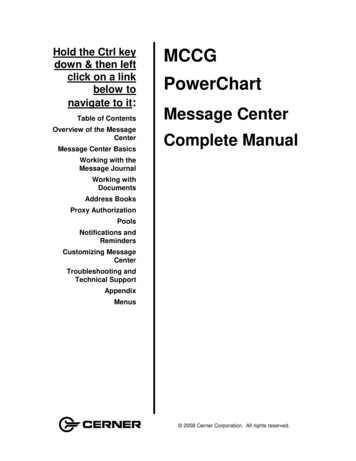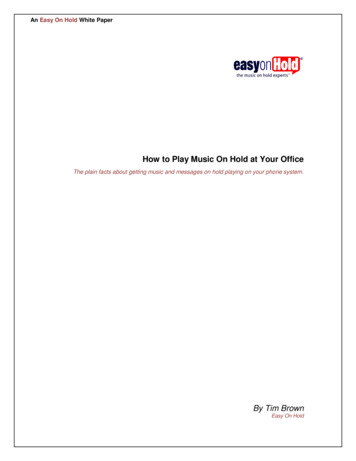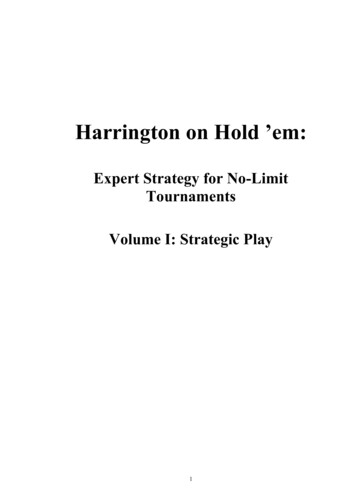
Transcription
Harrington on Hold ’em:Expert Strategy for No-LimitTournamentsVolume I: Strategic Play1
DedicationFor my mother, Alice HarringtonLadyfingers: You raised tens on lousy three-flush?The Man: That’s what it’s all about, isn’t it?Making the wrong move at the right time.From The Cincinnati Kid (1965)2
About Dan HarringtonDan Harrington began playing poker professionally in 1982. On the circuit he is known as"Action Dan," an ironic reference to his solid, but effective style. He has won several major nolimit hold 'em tournaments, including the European Poker Championships (1995), the 2,500No-Limit Hold'em event at the 1995 World Series of Poker, and the Four Queens No-Limit Hold'em Championship (1996).Dan began his serious games-playing with chess, where he quickly became a master and one ofthe strongest players in the New England area. In 1972 he won the Massachusetts ChessChampionship, ahead of most of the top players in the area. In 1976 he started playingbackgammon, a game which he also quickly mastered. He was soon one of the top moneyplayers in the Boston area, and in 1981 he won the World Cup of Backgammon in WashingtonD.C., ahead of a field that included most of the world's top players.He first played in the 10,000 No-Limit Hold 'em Championship Event of the World Series ofPoker in 1987. He has played in the championship a total of thirteen times and reached the finaltable in four of those tournaments, an amazing record. Besides winning the World Championshipin 1995, he finished sixth in 1987, third in 2003, and fourth in 2004. He is widely recognized asone of the greatest and most respected no-limit hold 'em players, as well as a feared opponent inlimit hold 'em side games. He lives in Santa Monica where he is a partner in Anchor Loans, areal estate business.About Bill RobertieBill Robertie has spent his life playing and writing about chess, backgammon, and now poker.He began playing chess as a boy, inspired by Bobby Fischer's feats on the international chessscene. While attending Harvard as an undergraduate, he became a chess master and helped theHarvard chess team win a number of intercollegiate titles. After graduation he won a number ofchess tournaments, including the United States Championship at speed chess in 1970. He alsoestablished a reputation at blindfold chess, giving exhibitions on as many as eight boardssimultaneously.In 1976 he switched from chess to backgammon, becoming one of the top players in the world.His major titles include the World Championship in Monte Carlo in 1983 and 1987, the Black &White Championship in Boston in 1979, the Las Vegas tournaments in 1980 and 2001, theBahamas Pro-Am in 1993, and the Istanbul World Open in 1994.He has written several well-regarded backgammon books, the most noted of which are AdvancedBackgammon (1991), a two-volume collection of 400 problems, and Modern Backgammon(2002), a new look at the underlying theory of the game. He has also written a set of three booksfor the beginning player: Backgammon for Winners (1994), Backgammon for Serious Players(1995), and 501 Essential Backgammon Problems (1997).From 1991 to 1998 he edited the magazine Inside Backgammon with Kent Goulding. He owns apublishing company, the Gammon Press (www.thegammonpress.com), and lives in Arlington,Massachusetts with his wife Patrice.3
IntroductionPoker is a fascinating game with a long and colorful history. It originated early in the nineteenthcentury as a game called poque, centered in New Orleans and on the Mississippi riverboats.Poque used only 20 cards and permitted only one round of betting. Gradually, the game spreadacross the country, always evolving new forms as old variations became well-understood. Fivecard draw, five and seven-card stud, lowball, hi-low, and, more recently, Texas hold ’em andOmaha were a few of the variations that expanded the map of poker. As time passed, the gamecontinued to grow in popularity, from home games, to private gambling dens, to public casinos,to tournaments, to online play, and finally to televised tournaments.In the last couple of years poker has exploded in popularity with the advent of minicams thatenable television viewers to watch major events and follow the hands as they are played. As aresult, tournaments that were once dull as dishwater can now be followed on the screen withsome real understanding of what the players are trying to do. A game once mysterious hasbecome, improbably, the latest spectator sport.Television tournaments have focused on one variation of poker in particular - no-limit Texashold ’em. The no-limit variation has been used to determine poker's World Champion since thevery first tournament back in 1970. Nowadays there are about as many no-limit hold ’emtournaments as all other kinds combined, and every major tournament has a high-stake no-limitevent as its culminating contest. On television, you can watch no-limit hold ’em tournaments atleast three days a week (not counting reruns). Online, there are thousands and thousands of nolimit hold ’em tournaments every day, ranging from single table events with a 1 buy-in to multitable events with buy-ins of hundreds of dollars and prize funds of over 100,000.A gap, however, exists in the world of poker. In the bookstores, there are many, many pokerbooks, all teaching you how to play - limit hold ’em. There are hardly any books on the new ragethese days - no-limit hold ’em tournaments. This is understandable if you consider the history ofhold ’em. For many years there were just a few high-stakes no-limit hold ’em tournaments everyyear. Almost all the hold ’em action was in casino card rooms, where they spread limit hold ’emgames at varying limits. If you were a newcomer to the game, small-stakes limit hold ’em waswhere you started.But now that's all changed, and many newcomers are starting with various kinds of small-stakeno-limit hold ’em games and tournaments. So the need for a book dealing directly with this veryexciting and very complex form of poker is pretty clear. Harrington on Hold ’em: ExpertStrategy for No-Limit Tournaments, Volume I: Strategic Play is that book.OrganizationNo-limit hold ’em is such a big and complicated game that I couldn't squeeze all the informationinto just one book, so Harrington on Hold ’em is a two-volume set. In this first book, Volume I,I'll show you how to play in the beginning and middle stages of a no-limit hold ’em tournament.Part One serves as an introduction to the game as a whole. I'll show you why no-limit hold ’em isconsidered the "Cadillac of Poker," and what you need to consider when you try to evaluate ahand. I'll also take you inside a very interesting and complex hand from the final table of the2003 World Series of Poker. You might have seen this hand on television; I'll show you what theplayers were really thinking.Part Two covers playing styles. If you watched some poker on television, you've heard playersdescribed as "conservative," "aggressive," "super-aggressive," and "willing to play any twocards!" In Part Two I'll show what these terms really mean and how to play in each style. Mostimportant, I'll explain why you need to switch from style to style as the situation demands.4
Part Three, "Reading the Table," explains how to observe the action and keep track of bothphysical tells and betting patterns. It also explains how to observe yourself, and why that's soimportant.Part Four, "Pot Odds and Hand Analysis," explains all the math you'll need to know to play nolimit hold ’em. (There is some, but fortunately there isn't a lot.) The chapter covers pot odds,expressed and implied odds, and analyzing hands in relation to the odds being offered.Part Five covers the whole topic of "Betting Before the Flop." I'll introduce a complete strategyfor betting for value in pots that haven't been opened yet, and I'll also show you what hands youneed to call or raise for value when the pot has been opened in front of you.Part Six, "Betting After the Flop," shows you how to think about your hand when the floparrives. I'll show you a number of sample hands and compare them to various flops, explainingwhich flops are good, which are bad, and which are deceptively dangerous.Part Seven covers fourth and fifth street action, including getting extra money in the pot, playingagainst drawing hands, and betting (or not betting) on the end.In Volume II I'll talk about the tough issues involved in negotiating the later stages of atournament. There you'll find discussions of moves and bluffs, zones and inflection points, thestack ratio and what it means for your play, changing your style, playing short tables, andhandling heads-up play. Master the material in these two books, and you'll know how to win ano-limit hold ’em tournament. The rest is up to you.The HandsMuch of the real value of these books lie in the sample hands, which are collected at the end ofeach chapter. You should treat these hands as small quizzes, and try to answer the questionsbefore moving on to the explanations. It would be easy to read through the text and convinceyourself that, of course, you would have made exactly that play at the table, but you'll find theexplanations much more informative if you wrestle with the questions on your own first.The hands have been compiled over the years from a variety of sources, including my own play,hands I've seen in major tournaments, satellites, and online events. In each hand I've laid out thetable position and chip counts, as well as information about some of the players at the table, ifknown and pertinent to the hand. Study the hands, answer the questions, read what happens next,answer the next question, and in that way work yourself through the hand. Some of the handshinge on the single crucial decision of whether or not to enter the pot. Others involve a series ofdifficult moves as the hand evolves. Take the hands seriously, study them carefully, and you'll bewell rewarded.Poker on television needs to appeal to a wide audience of mostly casual players. As a result, thehands selected for inclusion tend to be dramatic all-in showdowns and major clashes. I don'thave any quarrel with that; if I were a television producer I'd probably do exactly the same thing.But that's not real poker. Tournaments are won and lost in the trenches, where average-plushands butt heads with average-minus hands. That's the workaday world of no-limit hold ’em, andmost of the hands you'll find in this book are of that sort. My goal is to teach you how to thinklike a poker player. Anyone can win a pot when he flops a monster. It's how you play when youdon't flop one that will decide whether you're a winner or a loser.With the help of this book, I hope you become one of those winners. This is not a beginner's book. I'm assuming that the reader already knows how to play no-limithold ’em, either from actual play, online play, or just watching on television. However, this isnot a complicated book either. I've tried to present the game the way I Play - with simple,5
common-sense rules and a minimum of mathematical calculation. A little math facility is a goodthing, and there are some simple percentages that you'd do well to commit to memory. But youdon't need to be a math whiz to play good poker. Keeping your head at the table and thinkingclearly is far more important. In many cases good arguments can be advanced for an alternate play to the one I recommend inthis book. No-limit hold ’em is not an exact science. My recommendations are always reasonablebut under certain conditions a different play could be slightly or even clearly better. Obviously,Bill Robertie and I can't enumerate every possible change in condition that would make this sowithout having a 2,000 page book. But with experience you should be able to recognize most ofthem when they come up.Brief GlossaryIf you've watched some television tournaments, you've probably picked up most of theterminology you need to read this book. But in case you've been out of touch the last couple ofyears, here's an explanation of some key terms, and it's also how I talk poker.All-in: A bet or raise of all the chips you have in front of you.Antes: Money placed in the pot by all players at the beginning of a hand. In a typicaltournament, players don't ante up until five or six betting rounds have passed.Big blind: A forced bet made by the player to the left of the small blind, to generate even moreaction.Big stack: The player with the most chips at the table. If he uses his chips to push the otherplayers around, he may be known as the table captain or table bully.Blinded away: If the player with the short stack doesn't play many pots, he may eventually loseall his chips when it comes his turn to play the blinds.Button: The player to the right of the small blind, who acts last on each betting round after theflop. The button is marked by a white disk which moves around the table counter-clockwise.Covered bet: Your all-in is covered if your opponent has more chips than you. In that case, youwill be eliminated if you lose the hand, but he will not.Cut-off seat: The player to the right of the button.Domination: When two hands share a common hole card, the player with the lower other card issaid to be dominated. When two players hold ace-king and ace-queen, the player with the queenis dominated.Flop: Three cards turned face up simultaneously in the center of the table. These cards arecommon to all hands. The flop is followed by a betting roundFifth street (also known as the "river"): The fifth and last card turned up in the center of thetable, also common to all hands. Fifth street is followed by a final betting round.Fourth street (also known as the "turn"): The fourth card turned faced up in the center of thetable, also common to all hands. Fourth street is followed by a betting round.Hole cards: The two down cards dealt to each player at the beginning of the hand. No otherplayer can see these cards.Initial pot
In the bookstores, there are many, many poker books, all teaching you how to play - limit hold ’em. There are hardly any books on the new rage these days - no-limit hold ’em tournaments. This is understandable if you consider the history of hold ’em. For many years there were just a few high-stakes no-limit hold ’em tournaments every year. Almost all the hold ’em action was in casino .




